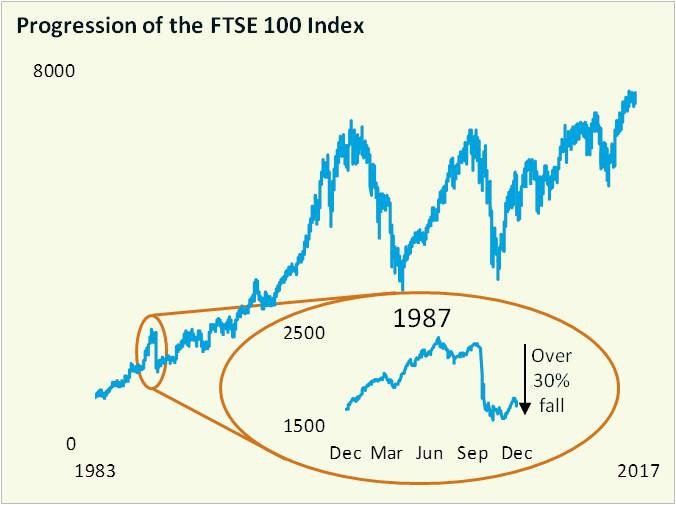The day that rocked the world
From the blog: Thirty years ago, October 19 1987 became known as Black Monday as global stock markets crashed. Black Monday remains the biggest one-day fall, of 22.6 per cent, in the US Dow Jones Index.
A driver of the falls was widespread use of computer programmes that were supposed to protect investors by selling when asset prices fall. However, this herd approach caused the falls to snowball.
Source: Datastream
The impact on pension scheme assets was huge, but conversely small on the funding position. Most schemes had around 85 per cent invested in equities. Schemes saw asset values fall 25-30 per cent in a month.
The approach to funding back then was very different. There was no Pensions Regulator, and the 1995 Pensions Act following the Maxwell scandal was years away.
Schemes saw little effect on their funding position as the actuary would simply adjust down the value of the liabilities in line with the asset falls. Consequently, contribution holidays could continue.
The impact was actually quite short-lived. The UK stock market recovered within 18 months, and it doubled within about eight years.
We’ve seen numerous stock market falls since, including the dot.com bubble and credit crunch. It actually happens fairly often. So the key question is, ‘When is it going to happen again?’
- In 1987, the US stock market P/E ratio was around 17. A high number represents more excessive valuations. Today, it is 31.
- Stock market volatility was around 22. A higher number means greater volatility is expected. Today, the equivalent value is 8.
So market prices are high and investors expect prices to stay benign. Investors’ apparent current benevolence worries me.
If a similar event happened today, the outcome would be dramatically different. A more diversified growth portfolio and the use of gilts and liability-driven investment would mean asset falls would be lower.
Today nearly all schemes use a ‘gilts plus’ valuation (another herd approach). This means future investment returns are based on gilt yields. A flight to quality would see investors invest more in gilts, causing gilt yields to fall and scheme liability values would increase. So unless 100 per cent hedged, funding positions would worsen, and sponsoring companies might be asked for more cash.
For schemes it is important to think carefully about what needs to be achieved, and how. Manage risk carefully and don’t automatically do what everyone else does – the consequences can be surprising.
A lot has changed and I cross my fingers it’s for the better, but I do worry that lessons haven’t been learnt.
Ben Gold is head of pension investment – north at consultancy Xafinity
Most Viewed
- LGPS latest: GLIL backers invest £475m for UK infrastructure push
- What does Labour have in store for the pensions industry?
- Dashboard costs rose by 23% in 2023, figures show
- Border to Coast launches UK strategy in major private markets push
- How the pensions industry can better support people with mental health problems


